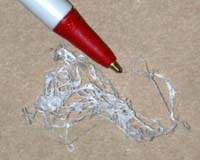Floating White Ropy Strands Cause Stir- Probably from Woolly Aphids but There Are Other "Floaters" Now, Too
Floating White Ropy Strands Cause Stir- Probably from Woolly Aphids but There Are Other "Floaters" Now, Too

Published on October 17, 2001
Floating ropes of a white, waxy material have filled the air around Henderson, Owensboro, and Evansville, Ind. These floating strands are no cause for alarm.
Samples sent from Owensboro were waxy filaments of a woolly aphid, such as the woolly alder aphid, said Lee Townsend, University of Kentucky Extension Entomologist.
This insect is common on silver maple and alder. These sap feeders produce large amounts of honey dew. This clear sticky substance soon covers the foliage and branches, as well as cars and buildings underneath or adjacent to the infested tree. Often foliage becomes black from the sooty mold that grows on the honeydew.
Heavy infestations may result in the ground being littered with the white, waxy threads under silver maple.
Throughout early summer, look for white, wool-like waxy filaments on branches and stems of host trees along with conspicuous curled leaves. The presence of honeydew, ants feeding on honeydew, or development of sooty mold are commonly associated with aphid infestations.
The insect overwinters on maple bark in the egg stage or on alder in tightly-clustered, wool-covered aphid colonies. Newly-emerged aphids settle on the midvein of new maple leaves. These aphids reproduce asexually, producing very large colonies.
The winged generation that develops flies to alder in July. Several generations may develop on alder, accompanied by production of large amounts of white, waxy material. Some of the migrants fly back to the trunk and branches of maples, where they mate and produce eggs, one per aphid. Others remain on the alder in the adult stage.
The insect usually is of little significance, although the amount of white, waxy material that accumulates may be troublesome and some of the infested leaves prematurely drop. The associated honeydew and sooty mold also may be annoying.
Ballooning of arthropods also can produce "floaters" in the air, Townsend said. "Ballooning" is a means of aerial dispersal that can be used by several spider species. These floating silk strands (often 2 feet or greater in length), sometimes called "gossamers" are an ethereal sight on a sunny fall afternoon but they can cause concern and 911 calls to emergency agencies at a time when anything out of the ordinary is seen in the air.
Ballooning spiders will move to the tops of vegetation or other high spots, stand on their "tiptoes", and release silk from the spinnerets at the end of their abdomen. When long enough, the silk will be captured by a breeze and the spider will be lifted into the air for a flight that can reach several hundred feet in the air and carry the 8-legged aeronaut several miles.
Large numbers of spiders can be afloat at the same time, filling the air with silken strands that waft and twist gently in the breeze. They can catch on tree limbs, fences, or any other objects.
Ballooning activity occurs on warm days following cold nights. This sudden rise in temperature creates updrafts that provide ideal conditions for liftoff. This pattern has occurred over the Commonwealth and floating strands can be seen most anywhere.
Several families of spiders that are common in Kentucky are known to use silk to disperse. Some of the more common groups are wolf spiders, line weaving spiders, dwarf spiders, jumping spiders, and crab spiders. This mode of transport can be used by young spiderlings or adult males and females. It may be possible to find the spider on the silk.
